The King {K} may move one square in any direction, so long as no piece is blocking his path. (the king is the only piece that does not have a point value)
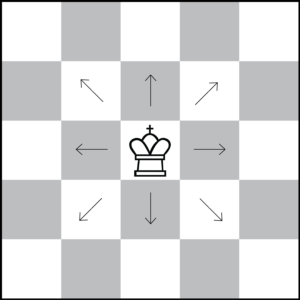
The King may not move to a square:
- that is occupied by one of his own pieces,
- where it is checked by an enemy piece
- adjacent to the enemy King
The Queen {Q} may move any number of squares straight or diagonally in any direction. (The Queen is worth 9 points)
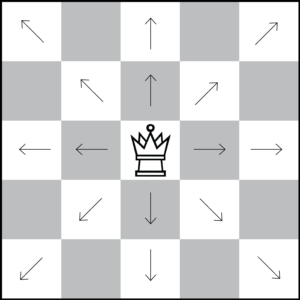
The Dragon Bishop {Δ} moves and captures like a normal classical Bishop diagonally and a Xiangqi horse [not jumping over pieces like a Knight but moving one square vertically or horizontally, followed by one square outward diagonally] - (The Dragon Bishop is worth 6 points)
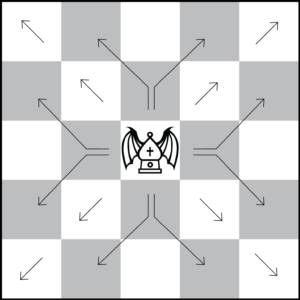
Dragon Bishop Movement (Unobstructed)
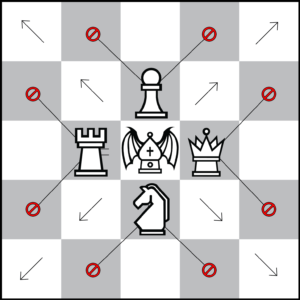
Dragon Bishop Movement (Obstructed)
The Rook {R} may move in a straight line, any number of squares horizontally or vertically. (the Rook is worth 5 points)
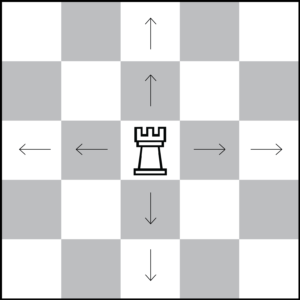
The only piece that can jump over a piece - be it your own, or the opponent’s - is the: Knight {N}. (The knight is worth 3 points)
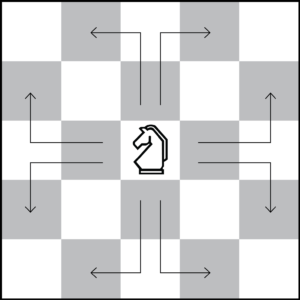
The Knight can jump to any square in L shape. This is the only piece that can jump over a piece in its way.
The Pawn on its first move may move either one or two squares straight forward.
(The Pawn is worth 1 point)
After its first move, the Pawn may only advance one square at a time. The Pawn captures by moving diagonally one square forward in each direction. The Pawn cannot move or capture backward!
PAWN PROMOTION
If a White Pawn reaches the 8th (or 1st with Black) rank of the board, it must be exchanged. It can be promoted to a Queen, Rook, Dragon Bishop or Knight of its own colour. But never to a King!
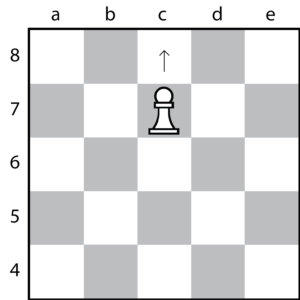

EN PASSANT
The possibility of en passant Pawn capture arises when the opponent’s Pawn has just moved from its starting position two squares ahead and our Pawn is next to it. This kind of capture is only possible at this time and cannot be done later.
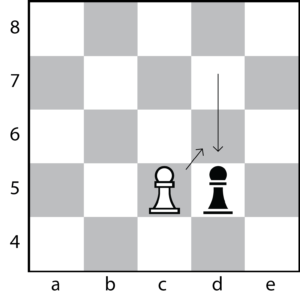
CASTLE
The King moves two squares in the direction of the Rook, the Rook jumps over the King and lands on the square next to it.
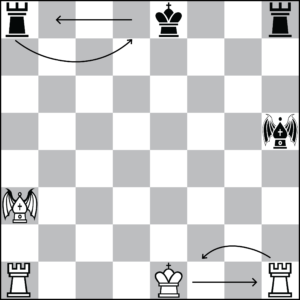
- You cannot castle:
- if the King is in check
- if there is a piece between the Rook and the King
- if the King is in check after castling
- if the square through which the King passes is under attack
- if the King or the Rook has already been moved in the game
CHECK
A King is in check when it is attacked by the opponent’s piece. The King can never be captured.
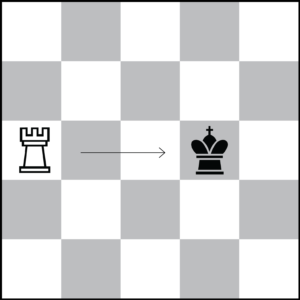
- A King must get out of the check immediately:
- by moving the King
- by capturing the piece that gave the check
- or by blocking the check with one of the pieces of his team. This is impossible if the check was given by the Knight.
MATE (CHECKMATE)
If the King cannot escape from the check, the position is checkmate and the game is over. The player who got checkmated gets zero point and the player giving mate gets one point.
STALEMATE & DRAW
There are three possible results in a chess game. If neither side wins, the game is a draw and both players get half a point. A draw is half as good as a win, but much better, than losing.
- The different forms a drawn game are the following:
- Stalemate. When a player whose turn it is has no legal moves by any of his/her pieces, but is not in check.
- Perpetual check & three times repetition
- Theoretical draw (when there are not sufficient pieces on the board to checkmate)
STARTING THE GAME

Paradigm Chess30 is played on a normal 8x8 chess board with all the normal chess pieces on both sides (1 King, 1 Queen, 2 Rooks, 2 Knights and 8 Pawns), but the two normal chess Bishops are replaced with two Dragon Bishops.
In accordance with the nature and complexity of Paradigm Chess30, the chess pieces will be shuffled with only King, Rooks and Pawns remaining on original starting squares as per normal chess to ensure normal castling. Thirty positions could be generated by using the computer program on chess.com or simply by rolling a die to randomize piece placement to vacant squares.
In some instances, the Dragon Bishops will start on the same colour squares (two dark-squared/two light-squared).
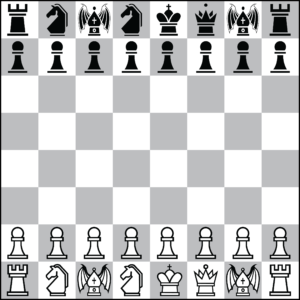
CHESS NOTATION & ORIENTATION ON THE BOARD

1. Write the symbol of the chess pieces with CAPITAL LETTERS: K, Q, R, Δ, N
2. The vertical files are marked with 8 letters, from left to right: a, b, c, d, e, f, g, h
3. The ranks are marked by numbers from bottom to top: 1, 2, 3, 4, 5, 6, 7, 8
The bottom left-hand corner is called a1 and it's a black square.
First we write down the name of the piece that moves, that is the symbol of it, which is usually the first letter of the word. For example: Qd5 means: the Queen moves to the d file and to the 5th rank.
The sign of capture: x Example: Rxf5 means: the Rook captures an enemy piece on the f file and on the 5th rank. This order only changes in case of Pawn moves. We don't write the name of the Pawn, only where it moves to. In case if there is a promotion, first write on which square the promotion is, and the choice of the promoted piece is marked only at the end. For example: d8Q means: On the d file, the Pawn reached the 8th rank and was promoted to Queen.
- Castle short side: 0-0
- Castle long side: 0-0-0
- Check: +
- Checkmate: #
- Good move: !
- Bad move: ?
- White wins 1-0
- Black wins: 0-1
- Draw: 1/2-1/2
Notation of a short chess game (standard chess position): 1. e4 e5 2.Nf3 f6 3.Nxe5 fxe5 4.Qh5+ Ke7 5.Qxe5+ Kf7 6.Δc4+ Kg6 7.Qf5+ Kh6 8.d4+ Qg5 9.Qxg5# 1-0
